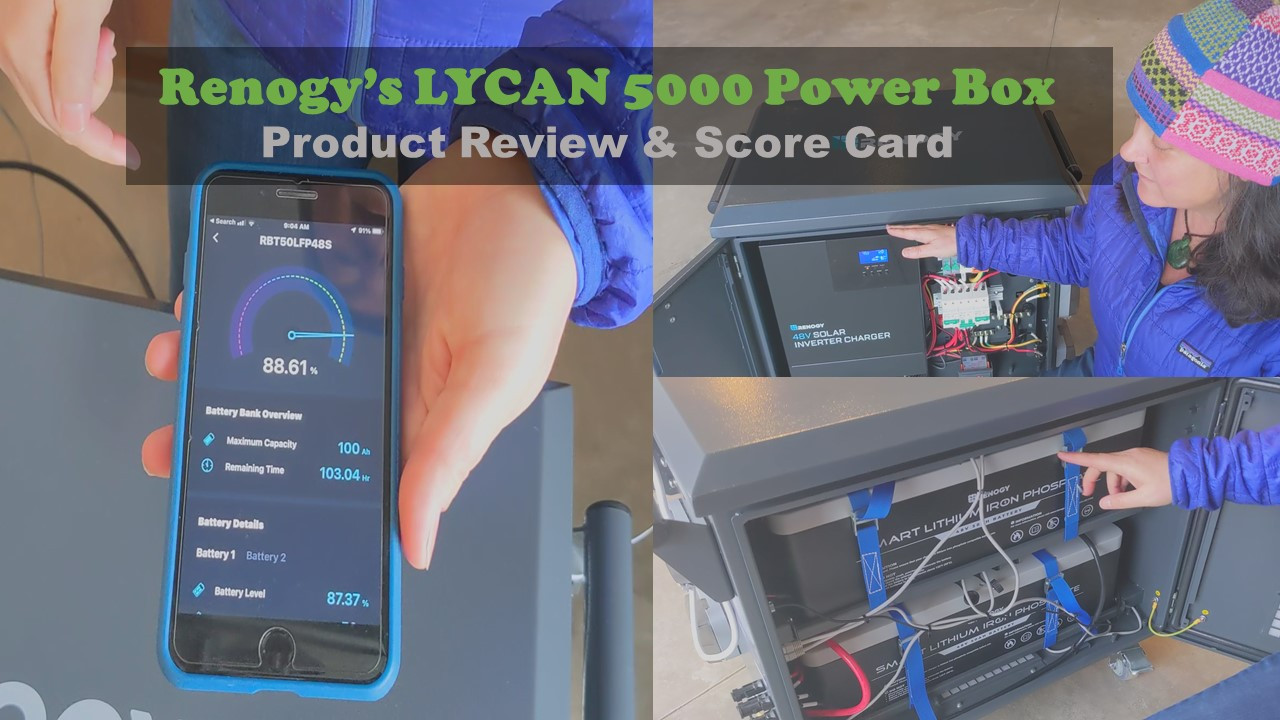Meet the LYCAN 5000: From Emergency Generator to Off-Grid Home Energy Supply
We’ve spent the past couple of weeks using and abusing one of Renogy’s newest state-of-the-art 48 volt products, the LYCAN Power Box. We have charged and discharged it numerous times, tested various appliances and tools using its 20A and 30A outputs, and monitored it all through the DC Home App. Here you will find a product review, as well as some tips for making the most out of this device. Be sure to check out our video product review for a hands-on tour, how we tested it, and more. Spoiler Alert…it exceeded our expectations!
What is the big deal about the LYCAN?
This all-in-one energy storage system is specially designed to supply power during emergencies, power outages, or even to provide power for off-grid homes. As a 48 Volt system, with a 4.8kWh capacity and a 3500W pure sine wave AC output (7000W peak power), the LYCAN can deliver power to most home and outdoor appliances. With its all-in-one design, it makes installing a full scale, yet portable, solar power system a breeze.
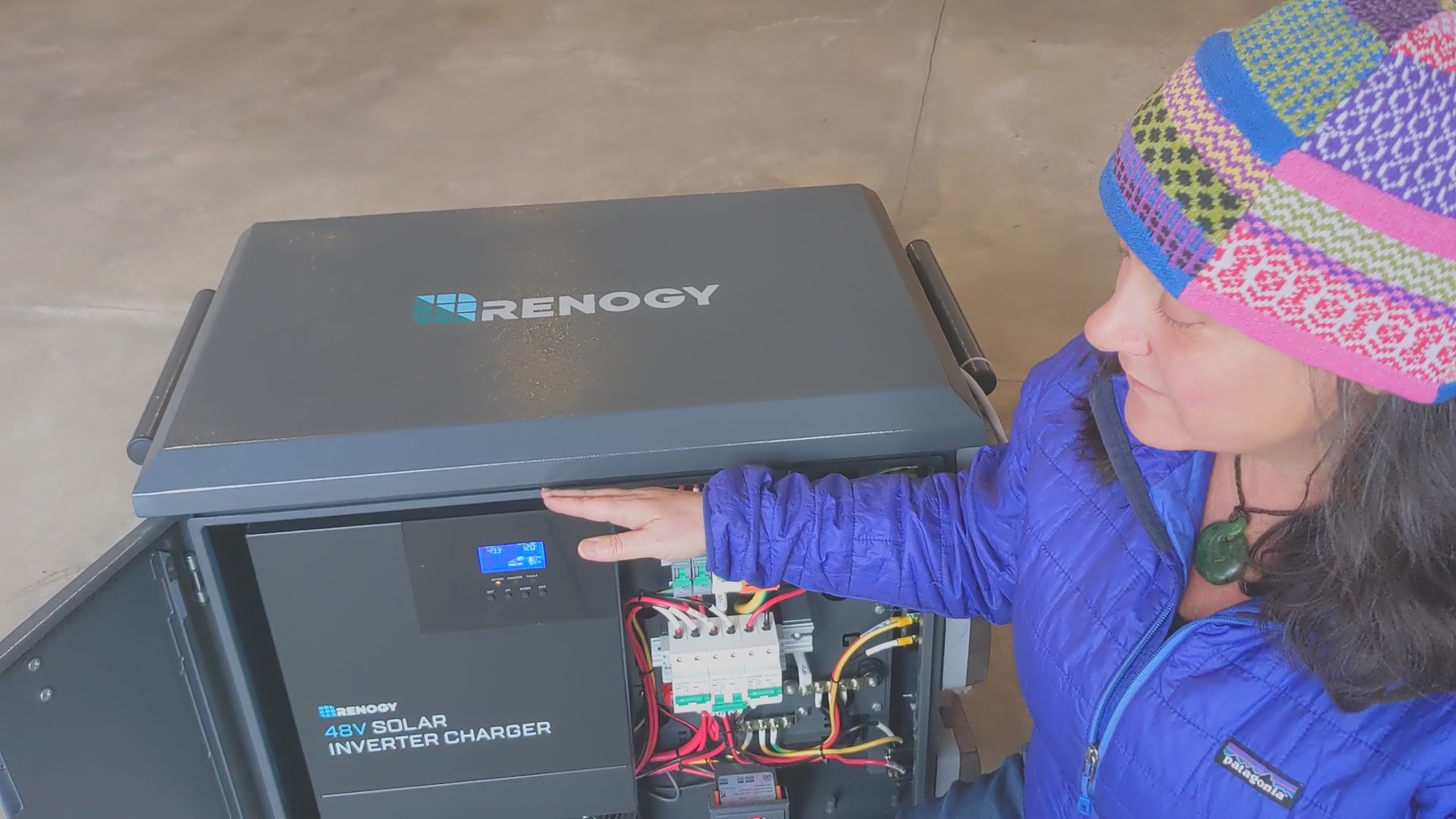
Can I Benefit from a LYCAN? Take the Quiz!
Answer YES or NO to the following statements:
- I live on-the-grid, but in an area with frequent and/or long term power outages.
- I want a quiet, portable generator that I could move around wherever I need it on my property.
- I dislike the constant noise of a gas-powered generator.
- I want to live in an off-grid cabin/home or large RV.
- I will be building my own off-grid home, cabin, barn, outbuilding, etc. and need a reliable power supply during the construction phase.
If you replied YES to any of these statements above, this innovative device will be a lifesaver!
How does it work?
If you are familiar with portable power stations like the Phoenix 300(built in charger, battery, and inverter), the LYCAN is just that, but on steroids! It includes Renogy’s latest 48V technology* – all in one sturdy box. It boasts 2 x 48V 50Ah Lithium Iron Phosphate batteries (equipped with a self-heating function and a Battery Monitoring System), a 48V 3500W Solar Inverter Charger(which is an inverter, battery charger, and charge controller all in one), as well as a BT-2 Module and Communication Hub for monitoring your system via your smartphone. All of these components are connected with appropriate wiring, fuses, surge protection, and breaker box. All breakers are clearly labeled and easy to operate. Though this unit weighs in at a whopping 256 pounds, the unit is surprisingly maneuverable with its 4 wheels; but, we would not recommend carrying it up and down stairs regularly. *Note: If you are new to 48V solar technology, head on over to our recent article to learn the latest.

How long does it take to charge?
It can take a solar input (up to 4400W) or 20A AC input (up to 2400W). Combine these two sources, for a total of 6800W. While we were not able to confirm this statement because we do not have a sizable solar array, the User Manual states that it takes just over 1 hour to fully charge with both sources combined. With just AC power, we noted that it takes about 3.5 hours to fully recharge from 20% (the safe depth of discharge) to 100%. If using it as emergency back-up power, we recommend charging it up well ahead of time.
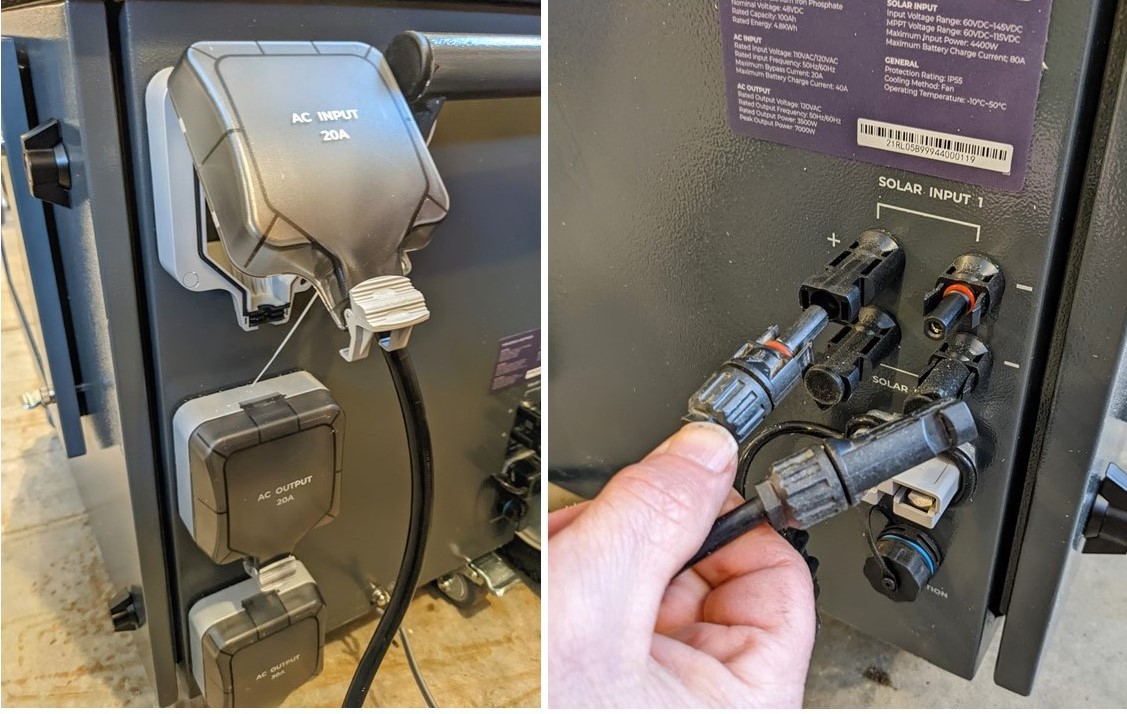
Is it safe to use?
The LYCAN is equipped with circuit breakers and surge protection devices. Preventing overvoltage, overload, and lightning strikes on the equipment to ensure safety. Before you install it, you will also be adding a ground wire, for added safety. This is not included in the package, but the instructions for doing this are simple and clearly described in the User Manual.
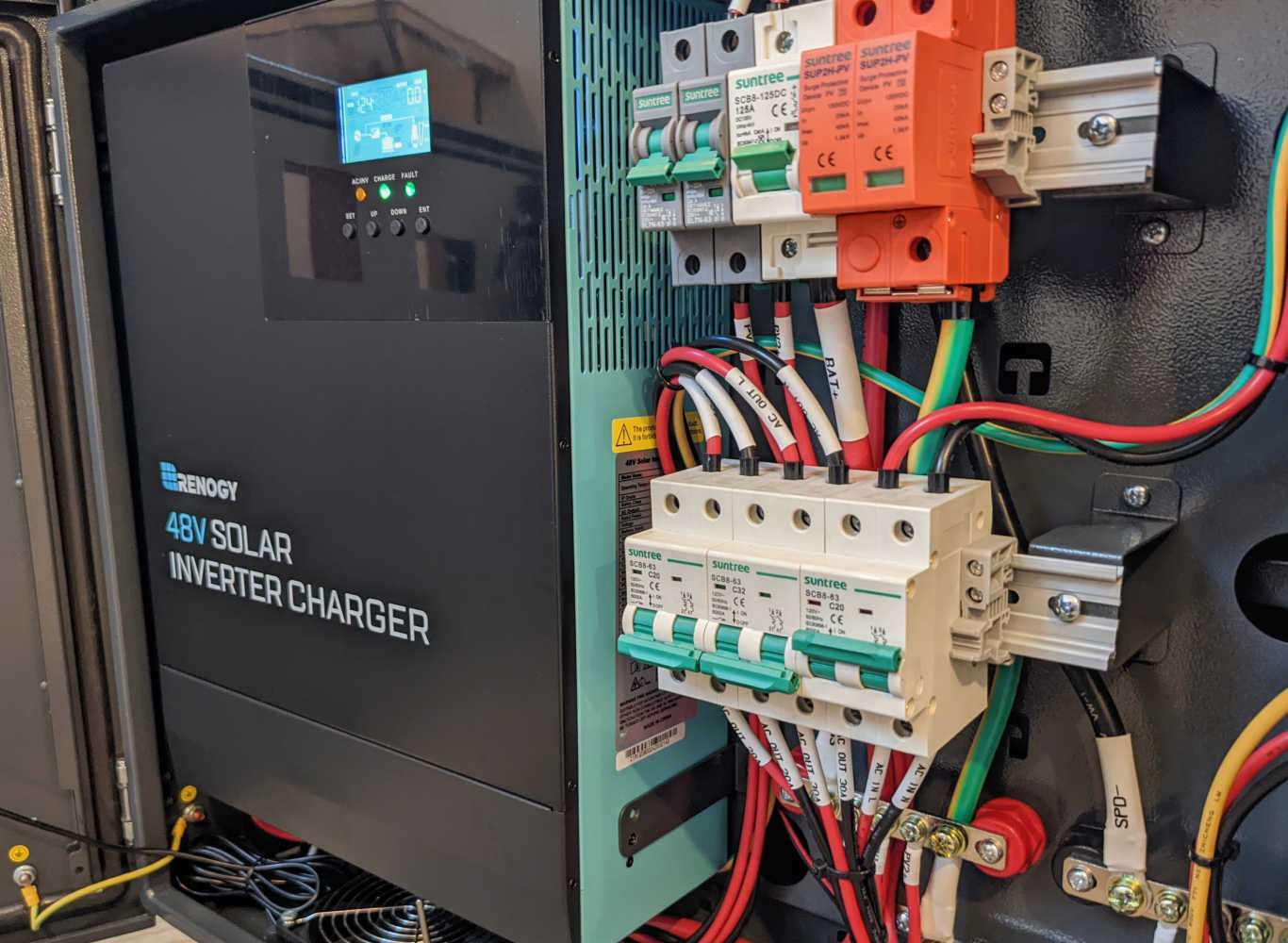
What can it run?
The 4.8kWh LYCAN can easily power most heavy-duty home and outdoor appliances with a continuous power output of 3500W and an impressive peak power of up to 7000W. It offers a 20A AC output to run basic household appliances, as well as a 30A AC output for more heavy duty equipment or larger household appliances. If that’s not enough power for your total energy needs, the LYCAN can be easily expanded to up to 19.2kWh by adding up to 6 additional Renogy 48V 50Ah Smart Lithium Iron Phosphate Batteries, covering most any situation from short term power outages to full energy independence. Keep in mind, you will still be limited to the 3500W inverter capacity even if you add more battery storage.
Renogy claims that the LYCAN can power a 135W refrigerator for 60 hours, a 1000W air conditioner for about 6 hours, or run a 500W washing machine 8 times. It can also run multiple appliances at once using both 20A and 30A outputs (using appropriately sized extension cords), or by hooking the unit directly into your house electrical system.
We did our own appliance test using the 20A and 30A outputs. We focused on how the unit would handle higher wattage appliances like heaters, instant pots, microwaves, power tools, etc. – both in the house as well as in Hutch’s parents’ Winnebago travel trailer.
To test the 20A output, we plugged in several high wattage household appliances such as a coffee maker, blow dryer, electric kettle, toaster, microwave, instant pot, electric heater – all with no problems. We found that we were able to run 2 higher wattage appliances (e.g., toaster and coffee maker) at one time, but when we added a third high wattage appliance like a hair dryer, it tripped the breaker. Thus, the system worked as expected and as it is designed to do. Note: You would be able to run a toaster, coffee maker, TV/laptop, and lights as those appliances combined would come in under 20A (max output) and 3500W (max load). We also used the 20A output to run large power tools such as a table saw, shop vac, and compound miter saw – again, it worked great! This unit would make a great power source for an off-grid construction project.

To test the 30A output, we rolled the unit through the ice and snow out to Hutch’s parents’ travel trailer and used their 30A power cord to power the entire camper. We tested their higher wattage appliances such as the microwave, heater, electric skillet, and coffee maker, while also running any phantom power sources such as the fridge, LP gas detector, and clock on the stereo. We spent the better part of the day testing the unit and cleaning out their camper to get it ready for camping season. In doing so, we ran the handheld vacuum, made coffee, ran the heater, etc. For a final test of the peak power and circuit breaker functionality, we used the 20A output to run a blow dryer, while also running two other high wattage appliances on the 30A. It ran for about 20-30 seconds, then tripped the breaker. This would overload any 30A output at a campground as well, so we were satisfied that it sustained a peak load, then tripped the circuit breakers as expected. At the end of the day, we even had 53% of the battery left. Impressive!
How do I install and use the LYCAN?
Right out of the crate, you need to ground the unit as directed in the User Manual (grounding cord and stake not included). Next, you’ll need to charge it up with the power cord that comes with the unit – just follow the 3 simple steps described in the manual and you’ll be set. Note: To take full advantage of 20A when charging, you may need to replace one of your standard 15A outlets with a 20A outlet (be sure that the household circuit is rated to handle 20A). This cost about $4 at a local hardware store and took about 20 minutes.
Depending on how you plan to use it, there are different ways to install this unit. Specific details can be found in the User Manual, but here’s a brief overview:
- As an emergency or back-up power supply, just ground the unit and charge it up ahead of time, then move it around to wherever you need a power supply in your home or on your property. It can be used with or without a solar array. With both 20A and 30A extension cords, you can run or charge multiple appliances at once. The LYCAN can be used in very cold temperatures as the batteries are self-heating, keeping the batteries above 41 degrees Fahrenheit so that they will charge properly and not damage the batteries.
- If you are building your own off-grid cabin and need a power supply for your tools and/or a temporary shelter on your land during the construction process, this power box is a great option. You may want to install your solar array first, so this device will charge via the sun but you can also charge it via a gas generator or with a 20A AC outlet as needed. Once your off-grid cabin/home is built, the LYCAN can become your main source of power, connecting directly to your home’s breaker box. If your energy needs are greater than the LYCAN’s built-in battery bank, it can be augmented with up to 6 additional 48V 50Ah LFP batteries, connected in parallel. It is also important to note that the LYCAN is water-resistant but not waterproof, so you’ll want to house the unit in a waterproof shed to protect it.
- If you live in an on-grid home in an area with frequent power outages, this device can be connected directly into your home’s electrical box using either a manual or automatic transfer switch. When your power goes out during the next storm, the LYCAN kicks right in, just as a gas generator would, but without the noise. Again, the battery bank can be expanded if your energy needs exceed the demands of the LYCAN’s battery bank.
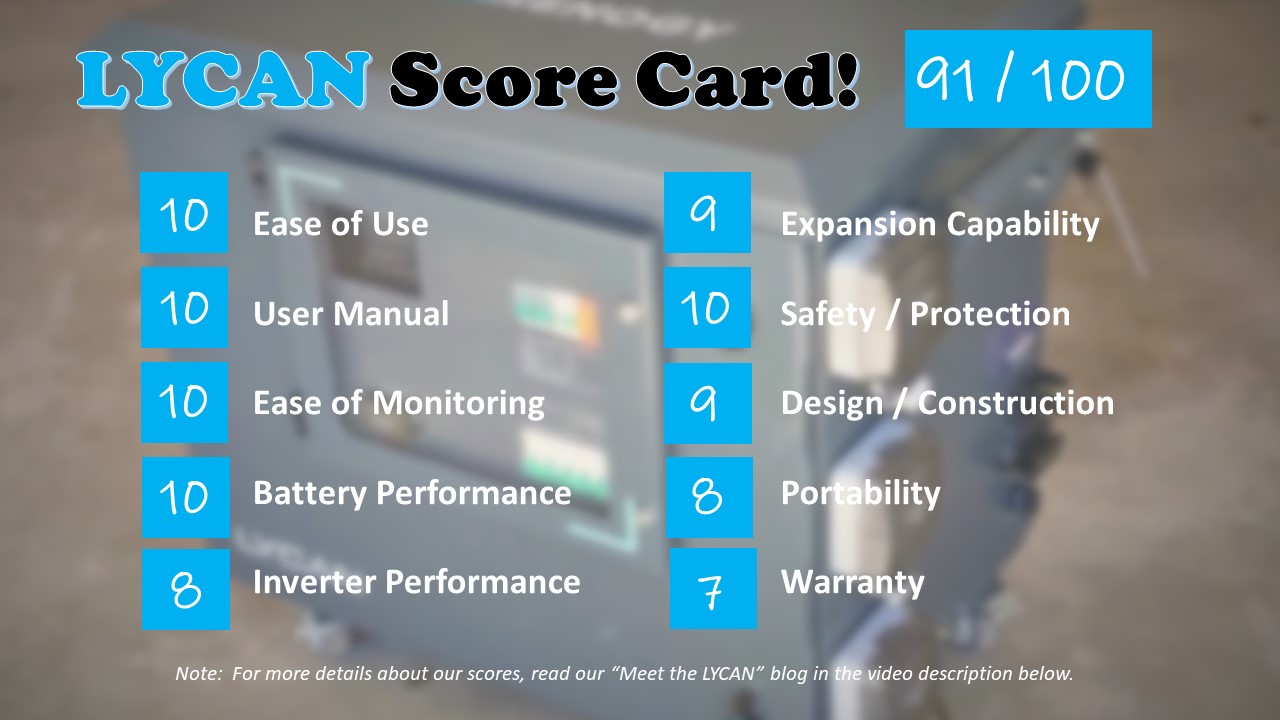
Overall Thoughts & Score Card
Overall we were impressed with the thought and design of this unit – Renogy has combined all of their latest and greatest technology into one portable unit. It worked as expected, even exceeding our expectations in some categories. We gave the product an overall score of 91 out of 100. Here’s how the LYCAN ranked in the following categories, using a 10 point scale (10 = best, 1 = worst):
- Ease of Use:10 It is very simple to use and designed as a plug and play. If you can turn on and use a computer, you can operate this unit.
- User Manual:10 Instructions are very easy to follow, with good diagrams. We had it up and running in minutes!
- Monitoring: 9 The BT-2 Module and DC Home app combination is an easy and thorough way to monitor the system. It’s easy to set-up, read, provides a great deal of information, and it works seamlessly with both Android and iPhone.
- Battery Performance:10 Exceeded our expectations here! They held up to many hours of testing numerous high wattage appliances. We love the BMS and self-heating aspect of these batteries. After leaving them on in a cold garage below 40 degrees for over 12 hours, the self-heating function used less than 1% of the battery’s power.

- Inverter Performance: 8 Very powerful and performs well under high wattage loads. Large inverters naturally draw a lot of power just running themselves. This unit is a charge controller, charger, and inverter all-in-one, so it uses quite a bit of power (just under 1% of the battery’s total capacity per hour of use). Be cautious of this if you have an extended power outage (2 or more days), especially if you are not recharging the batteries with solar simultaneously.
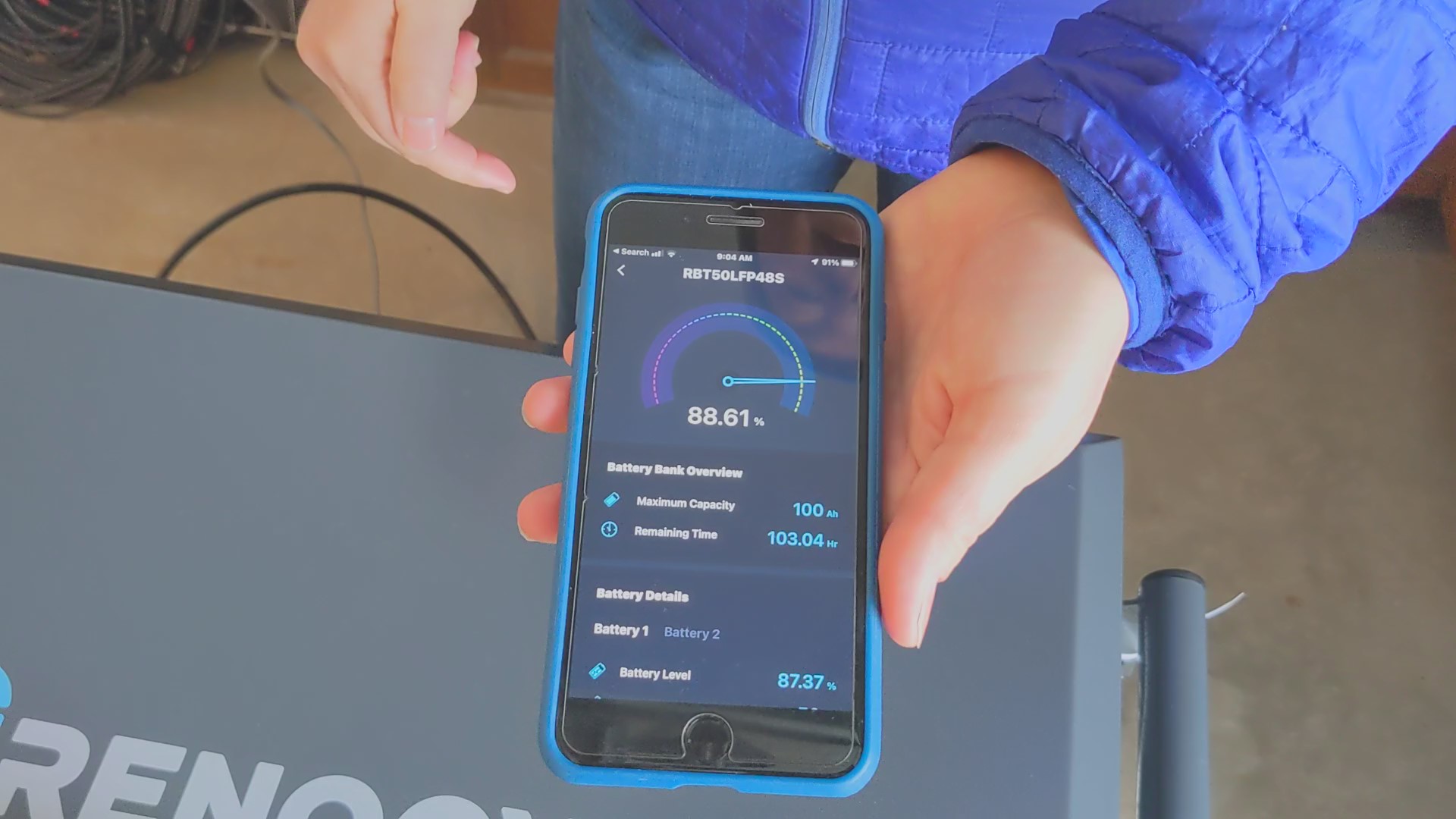
- Expansion Capabilities: 9 It is very easy to add extra batteries, but keep in mind that they cannot be nicely contained in the LYCAN’s box. The batteries will need to be outside of the unit, making the overall unit less portable.
- Safety / Protection:10 This unit is well-designed with appropriate cabling, circuit breakers, and surge protection. The batteries and inverter operate within parameters designed to keep both the batteries and your appliances safe. Note: It is important to ground the unit as directed prior to use.
- Design / Construction: 9 It is very solidly built and is water-resistant, and outlets have waterproof covers. The doors easily open, close, and lock to prevent theft of internal components. It has brakes on all 4 wheels, so it won’t roll down hill when you don’t want it to. The crate that it was shipped in was broken upon arrival, which is a design flaw of the crate/shipper rather than the product, but the latch for the 30A outlet cover broke during shipping. This is more of a bummer than a problem. Also, we found that we had to remove the waterproof housing for the 30A output in order to plug in the RV’s 30A extension cord as the shape of the cord was different than the shape of the housing, so make sure your 30A extension cord is compatible if you are planning to use the unit outside.
- Portability: 8 It rolls very easily on hard, flat surfaces. You can roll it across a yard or down a dirt path, but it isn’t easy. Since it weighs 256 pounds, it’s not easily moved up and down stairs – even using the solidly built handles. To get around this issue, we recommend using an extension cord rather than trying to move it.
- Warranty: 7 The battery has a 5-year prorated warranty, with all other components (solar inverter charger, BT-2 module, communication hub, and cables) carrying a 1-year material and workmanship and warranty. All circuit breakers and surge protection carry a 1.5-year material and workmanship warranty, and the enclosure (i.e., the external case and associated parts) carries a 3-year material and workmanship warranty. While these individual warranties are commensurate with other Renogy products, we would like to see a unit of this size and price tag with a warranty more like an appliance. Note: You can purchase an extended warranty for the LYCAN, but it is very expensive.

In 2012, Shari Galiardi & David Hutchison left behind careers and a comfortable home in North Carolina to travel with the vintage camper trailer they lovingly restored, outfitted with solar, and named "Hamlet." What began as a short break from careers and responsibility quickly turned into a love affair with roadlife. They have parlayed their higher education backgrounds, desire for life-long learning, and thirst for adventure travel into writing, photography, video production, and public speaking gigs from coast to coast. Known to their friends as simply Shari & Hutch, you can learn more about their full-time, solar-powered adventures on their website at freedominacan.com. Or, follow them on Facebook, Instagram, and YouTube as “Freedom in a Can, LLC.” Note: All links contained within this blog contain affiliate links provided by Freedom in a Can.

